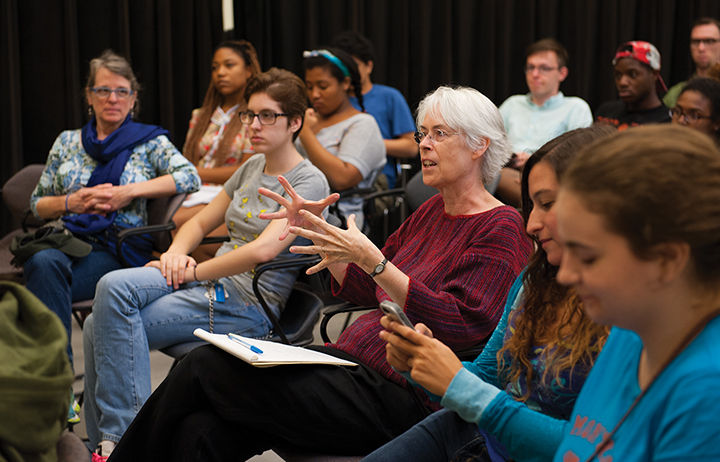
Mary Corbin Sies, of the department of American Studies, contributes to the Thinkathon, a discussion on how to improve the arts in College Park.
Students and staff members discussed improving Route 1 at the arts and humanities college’s Center for Synergy Thinkathon on Friday afternoon.
Organizers hosted the Thinkathon at the Clarice Smith Performing Arts Center as part of the 2014 NextNOW Fest in hopes of learning what students want to experience while attending this university.
“We’ve invited them to come and weigh in on arts and culture and how they feel arts and culture could transform Route 1,” said Monique Everette, director of marketing and communications at the arts and humanities college.
About 20 students, in majors from music and studio art to computer science and engineering, attended the Thinkathon to voice their opinions, recommending an enhanced downtown area and increased green space in the city.
“They didn’t say, ‘We want a traditional college town,’ but that’s what they described,” said Sheri Parks, associate dean for research, interdisciplinary scholarship and programming at the college’s Center for Synergy. “They want to be able to do things on Route 1 besides drink and eat pizza.”
Students proposed improving the safety and the general aesthetics of Route 1. They suggested cleaning the sidewalks, planting trees and installing decorative and functional medians and guard walls. Several attendees proposed building footbridges across high-accident areas, although this option would require more money and planning than other suggestions.
Some voiced other concerns, such as the lack of nightlife options for students who are younger than 21 or don’t drink. Students suggested opening a late-night cafe that would not serve alcohol and would offer a playful, comfortable environment.
Many students also expressed interest in bringing live music to College Park, either by creating a concert venue or opening a music store that could hold performances.
Others said that while they enjoy the arts, they have few opportunities to pursue them because art and music studios are reserved for those in music classes or ensembles.
“I love when people throw ideas out and then build on them, so this was very fun. It was very interactive,” senior studio art major Avid Antonelli said.
Sophomores Meg Cavanagh, who is enrolled in letters and sciences, and Jessie Doermann, a fire protection engineering major, attended the Thinkathon for a class assignment but stayed until the end because they enjoyed the conversation. Still, they expressed some doubt about the practicality of the proposed ideas.
“A lot of things people were saying were really abstract, artsy ideas that just would not be feasible,” Doermann said. “They would cost millions of dollars, and you would have to get so many permits and so much approval.”
Doermann said that in a perfect world, executing these projects would make College Park a much better place.
In the coming weeks, Parks said the Center for Synergy will be meeting with groups within the College Park community, including the City Council, the Lakeland community and area residents at the Prince George’s County Hispanic Festival, to gather more opinions before the larger College Park Think-A-Thon on Oct. 11. After this event, Parks and other members of the Center for Synergy will submit a report to university President Wallace Loh.
“The idea is to bring together … people who really could make something happen, to think through problems and challenges and utilize arts and culture as a vehicle to address those challenges,” Parks said.



